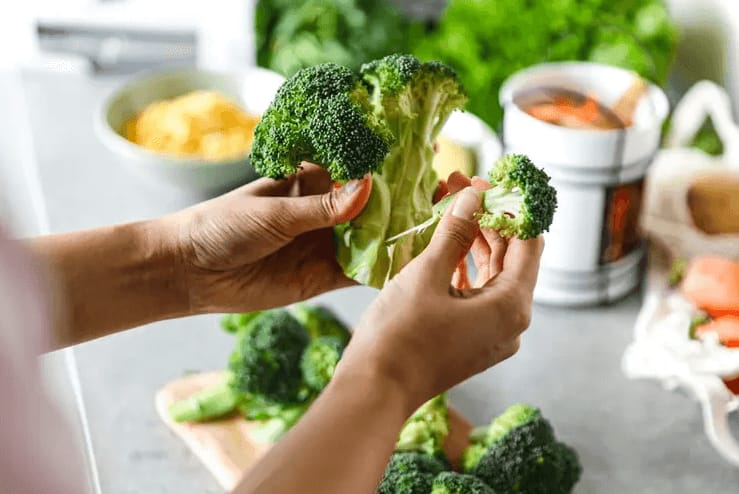- Thriving Guide
- Posts
- Best Cooking Methods to Maximize Broccoli’s Antioxidants
Best Cooking Methods to Maximize Broccoli’s Antioxidants
To unlock broccoli’s full health potential, it’s not just what you eat it’s how you prepare it that matters most.

Broccoli has long been celebrated as a nutritional powerhouse, but how you cook it may significantly impact its health benefits especially when it comes to antioxidants.
Recent research suggests that lightly stir-frying chopped broccoli can boost the availability of a powerful compound called sulforaphane, which plays a key role in reducing inflammation, fighting oxidative stress, and even supporting cancer prevention.
Here’s what to know about how cooking methods affect broccoli’s nutrition and how to prepare it for maximum health impact.
Why Sulforaphane Matters
Sulforaphane is a naturally occurring antioxidant found in cruciferous vegetables like:
Broccoli
Brussels sprouts
Kale
Cauliflower
It’s been linked to a range of protective benefits, including:
Detoxification support in the liver
Improved blood pressure and heart health
Reduced inflammation and oxidative stress
Cancer risk reduction, through inhibiting cancer cell growth and supporting detox pathways
But here’s the catch: sulforaphane doesn’t exist in its active form in raw broccoli. It’s produced when an enzyme called myrosinase helps convert a compound called glucoraphanin into sulforaphane. That means how you prep and cook your broccoli directly affects how much of this antioxidant your body can use.
The Best Way to Cook Broccoli for Sulforaphane
According to a study published in the Journal of Agricultural and Food Chemistry, two specific steps can significantly increase sulforaphane levels in your broccoli:
1. Chop Your Broccoli First
Chopping activates the myrosinase enzyme. Once activated, it starts converting glucoraphanin into sulforaphane. But here’s the key: wait about 90 minutes after chopping before cooking.
2. Lightly Stir-Fry It
High heat and long cooking times can destroy myrosinase. But light stir-frying preserves more of the enzyme while still making the broccoli tender. According to the study, this method resulted in the highest levels of sulforaphane.
“Preparation techniques, such as pre-cutting and light cooking, play a significant role in maximizing the health benefits of broccoli,” said Stephani Johnson, RDN, DCN, a nutrition expert at Rutgers School of Health Professions.
Why Steaming and Boiling Might Not Be Ideal
The study didn’t examine all cooking methods, but existing research shows that:
Boiling broccoli can significantly reduce vitamin C and sulforaphane
Microwaving and overcooking may deactivate myrosinase completely
Steaming lightly for 3–4 minutes may be a good compromise if stir-frying isn’t your thing
Still, light stir-frying with olive oil and garlic not only preserves nutrients it can boost flavor, making broccoli a dish you’ll actually crave.
Broccoli’s Other Health Benefits
Regardless of how you cook it, broccoli remains one of the most nutrient-dense vegetables on your plate. It's rich in:
Vitamin C and K
Potassium and calcium
Iron and magnesium
Lutein and zeaxanthin, two antioxidants known for supporting eye health
Fiber, which supports gut health and satiety
These nutrients make broccoli a valuable addition to any meal, whether you’re eating it raw, steamed, or cooked.
Should You Rethink How You Eat Broccoli?
If your go-to preparation is boiling or overcooking, it may be worth rethinking your method to get more from each bite. But nutritionists agree: the best way to eat broccoli is the way that keeps it in your diet.
“If raw broccoli sounds good to you, that’s a perfectly good reason to eat it,” Johnson noted. “Ultimately, eating broccoli in any form is better than not eating it at all.”
Quick Tips for Healthier Broccoli
Chop and wait: Cut your broccoli and let it rest for 90 minutes before cooking.
Lightly stir-fry: Use minimal oil and quick cooking to preserve antioxidants.
Don’t overcook: Aim for tender-crisp, not mushy.
Get creative: Add lemon, garlic, or red pepper flakes to boost flavor naturally.
If this article helped you rethink your cooking routine, share it or subscribe to our newsletter for more wellness-focused insights.